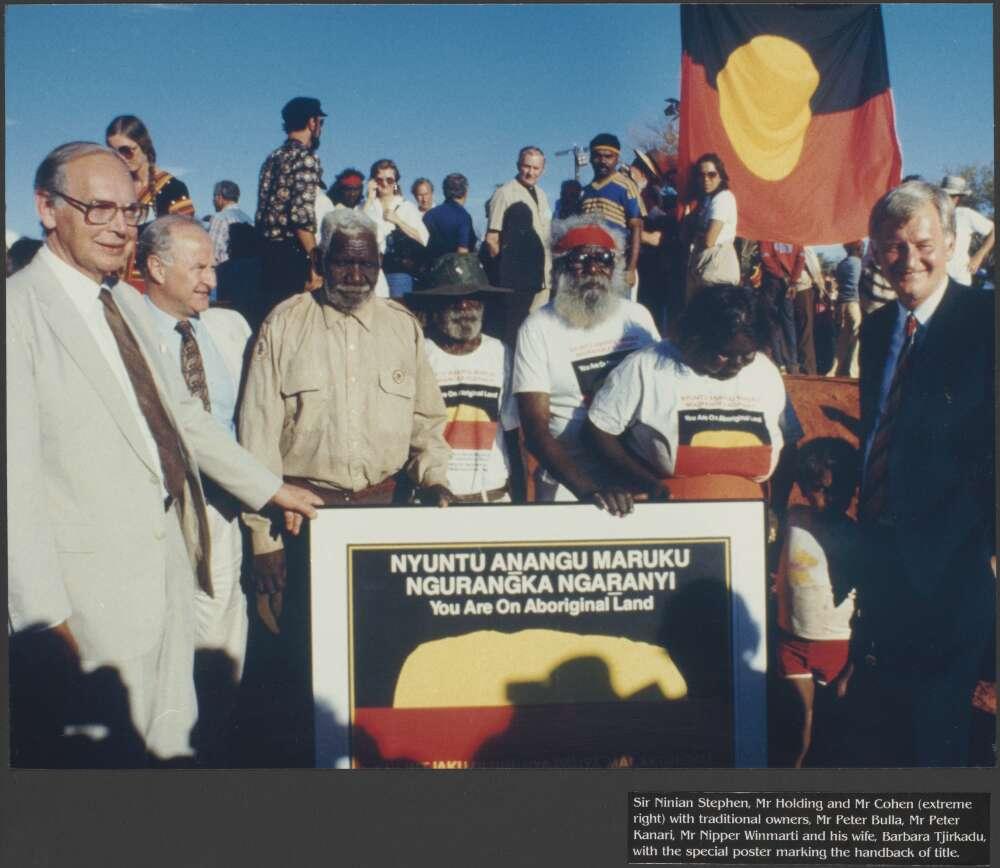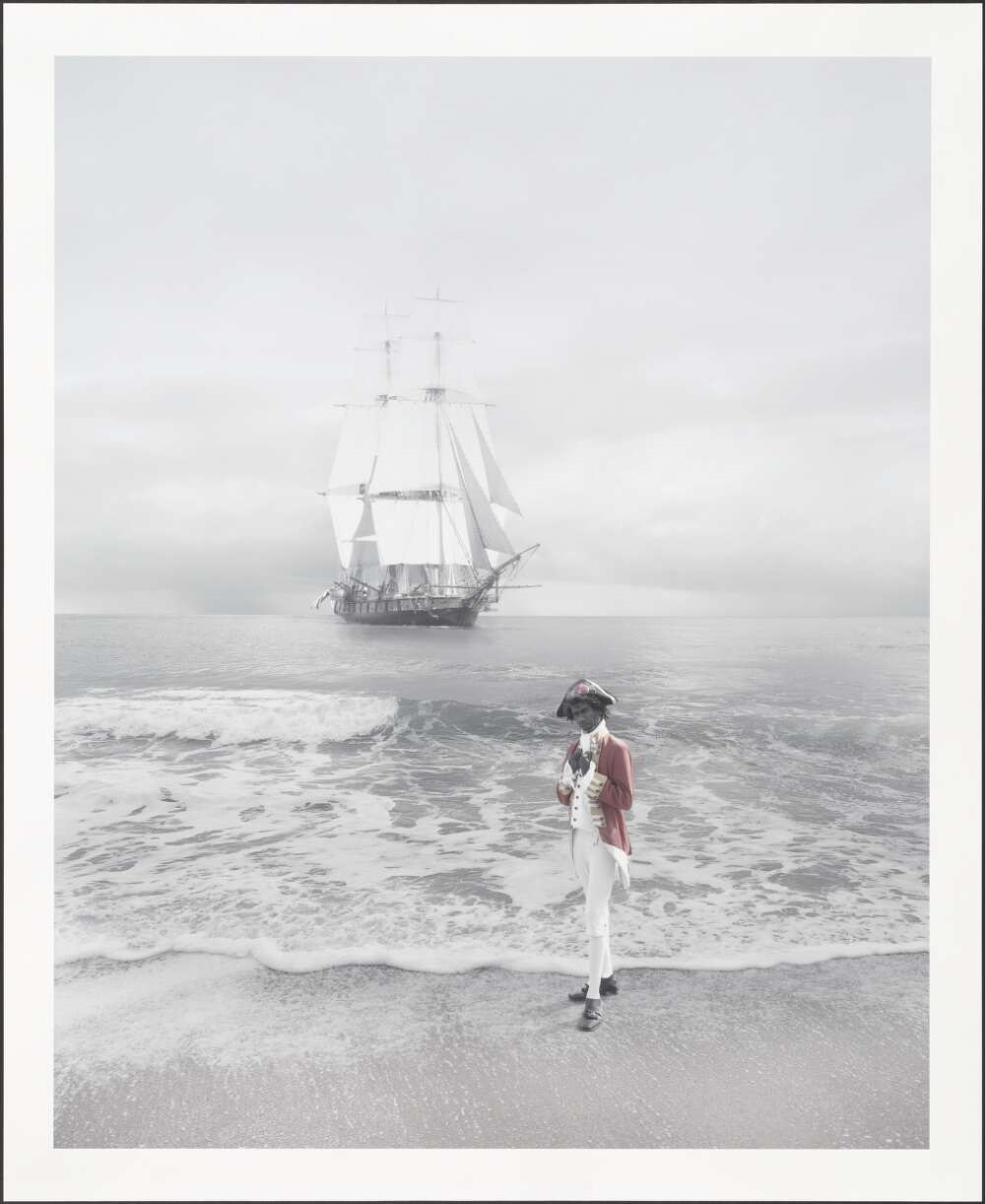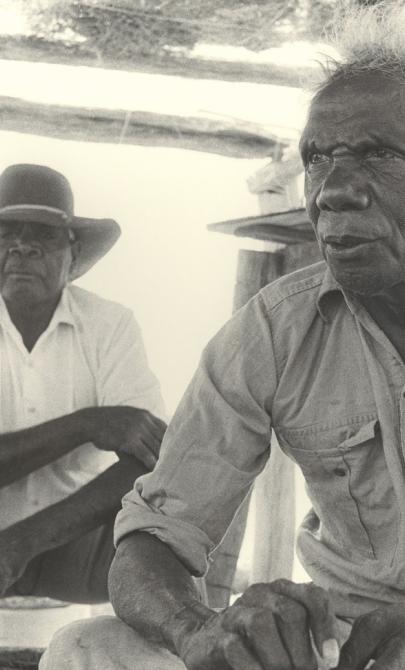Reshaping narratives of Australian history
Recognising First Nations culture and history
Events such as the 1967 referendum, the 1972 Racial Discrimination Act and the 1992 Mabo High Court decision marked official changes in government policy and engagement with First Nations people.
At the community level, many Aboriginal and Torres Strait Islander people have become increasingly vocal within cultural, political, business, educational and sporting domains.
As a result of these changes, Australians have an increased appreciation of First Nations cultures and histories, and a deeper understanding of the impacts and disempowerment that flowed from colonisation.

Department of Aboriginal Affairs. Media and Communications Branch & Uluru (Ayers Rock-Mt. Olga) National Park Handover/Leaseback Ceremony, Uluru-Kata Tjuta National Park (N.T.), Sir Ninian Stephen, Mr. Holding and Mr. Cohen (extreme right) with traditional owners, Mr. Peter Bulla, Mr. Peter Kanari, Mr. Nipper Winmarti and his wife, Barbara Tjirkadu, with the special poster marking the handback of title, 1985, nla.gov.au/nla.obj-147249245
Department of Aboriginal Affairs. Media and Communications Branch & Uluru (Ayers Rock-Mt. Olga) National Park Handover/Leaseback Ceremony, Uluru-Kata Tjuta National Park (N.T.), Sir Ninian Stephen, Mr. Holding and Mr. Cohen (extreme right) with traditional owners, Mr. Peter Bulla, Mr. Peter Kanari, Mr. Nipper Winmarti and his wife, Barbara Tjirkadu, with the special poster marking the handback of title, 1985, nla.gov.au/nla.obj-147249245
Welcome to Country and Acknowledgement of Country
All public events at the Library, and at a growing number of institutions across Australia, begin with either a Welcome to Country or an Acknowledgement of Country. Through such practices, the wider Australian community has the opportunity to gain greater familiarity with Indigenous cultures and languages.
At a recent conference at the Library, Ngambri-Ngunnawal custodian Paul House delivered the following Welcome to Country.
Language Keepers Conference; Paul House - Welcome to Country
Activity 1: What message did you take from the video of Paul House?
- In what contexts have you seen a Welcome to Country and what was your reaction?
- What does the increased use of such a welcome signify about recognition of Australia’s Aboriginal and Torres Strait Islander history?
Shifting attitudes to First Nations people and culture
Bruce Pascoe, a Bunurong/Tasmanian Yuin man, believes that there is evidence of change in the community’s attitudes to First Nations peoples and their cultures.
Bruce Pascoe - Australia has changed its mind; Eric Rolls Lecture
Activity 2: Has Australia changed its mind?
Bruce Pascoe suggests that ‘Australia has changed its mind’ about Indigenous and Australian histories.
- Do you agree with this statement?
- What evidence have you seen of such a change?
- What obstacles may there be to challenging the established way that Australian history has been told?
- What may contribute to reshaping history?
Changing national conversations
Pascoe’s comments reflect the attitudes and opinions of Australians from a wide range of backgrounds, perhaps suggesting a transformation in the national conversation about Australia’s history.
One historian who advocates the importance of engagement around these issues is Professor John Maynard, a Worimi man, who commented at a recent Library event.
We will always be a heavily marginalised minority unless we mobilise non-Indigenous support... We will have to reach out and get that support.
Professor Kim Scott, a multi-award winning Noongar author from Western Australia, believes that language could play an important role in this process. He spoke in 2019, also at the Library.
I’d like to think we can, in this beginning of a new era, utilise our Aboriginal languages to anchor a shimmering nation state, a shimmering settler colony, to this ancient continent through its home communities so that we can be in a position to be saying, in many languages all over the continent, that things are getting better.
How we tell Australia's story
In 2020, it was the 250th anniversary of Cook’s voyage to Australia. This is a pertinent time to reassess the way we tell Australia’s story.

Michael Cook, Undiscovered #4, 2010, nla.gov.au/nla.obj-708299938
Activity 4: How do we tell Australia's story, and who should tell it?
- In what ways is the story of Cook an Indigenous story? In what ways is it an Australian story? In what ways is it a European story?
- Who should take responsibility for the way the story of Cook and Australia is told?
- What do you think would be an appropriate way to mark future anniversaries of Cook voyage to Australia?



